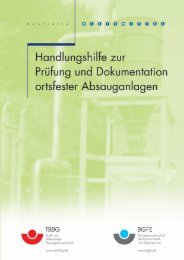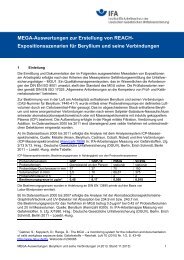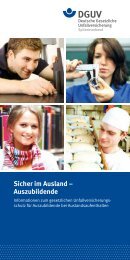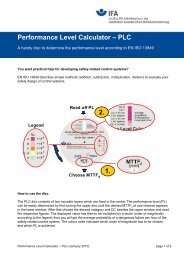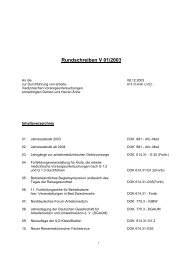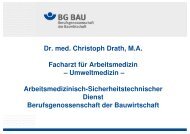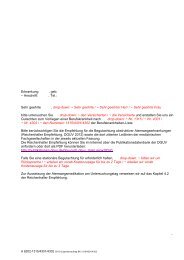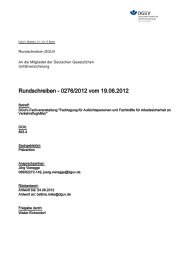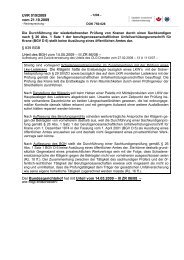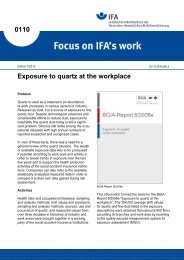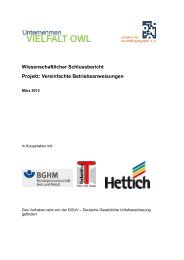Effectiveness of measures to prevent needlestick injuries among ...
Effectiveness of measures to prevent needlestick injuries among ...
Effectiveness of measures to prevent needlestick injuries among ...
You also want an ePaper? Increase the reach of your titles
YUMPU automatically turns print PDFs into web optimized ePapers that Google loves.
4 Intervention program evaluation<br />
did not specify whether or not the training interval was excluded from the analyses. In<br />
spite <strong>of</strong> training, staff reported difficulties using the Safety-Lok syringe, and compliance<br />
with use <strong>of</strong> this device was notably low.<br />
Sohn et al. [34; 35] used NaSH data <strong>to</strong> compare self-reported NSI for three years<br />
preceeding (1998 <strong>to</strong> 2001) and two years following (2001 <strong>to</strong> 2002) institution-wide<br />
introduction <strong>of</strong> various replacement devices (product names and manufacturers not<br />
specified) in a 427 bed tertiary-care hospital (US). The equipment included needle-<br />
safe intravenous (IV) delivery, blood collection, IV insertion, and intramuscular and<br />
subcutaneous injection devices. The specific devices were selected for broad introduc-<br />
tion and evaluation after a year <strong>of</strong> short-term piloting on various hospital units with<br />
evaluation by both nursing and medical staff.<br />
NaSH data allowed for calculation <strong>of</strong> NSI rates per full-time equivalent employee<br />
(FTE). Of the 529 blood exposure events reported during the entire study period, 449<br />
(84.9 %) were percutaneous <strong>injuries</strong>. During the 36-months preceding the intervention,<br />
390 NSI were reported, for a monthly average <strong>of</strong> 10.83 (standard deviation, SD ±<br />
3.02) and an annual average incidence rate <strong>of</strong> 34.08 NSI /1,000 FTE (SD ± 9.49).<br />
Following introduction <strong>of</strong> the safety-engineered devices, 59 percutaneous <strong>injuries</strong> were<br />
reported, yielding a monthly average <strong>of</strong> 4.92 NSI/1,000 FTE (SD ± 2.97) and a de-<br />
crease <strong>to</strong> 14.25/1,000 FTE annually (SD ± 8.61, p < 0.001 for both comparisons).<br />
Within occupational groups, nurses experienced the greatest reduction in injury rate<br />
(74.5 %, p < 0.001), followed by ancillary staff (61.5 %, p = 0.03). Statistically signifi-<br />
cant reductions were also observed for the specific activities: manipulating patients or<br />
sharps (83.5 %, p < 0.001), collisions or contact with sharps (73.0 %, p = 0.01),<br />
disposal-related <strong>injuries</strong> (21.41 %, p = 0.001), and catheter insertions (88.2 %,<br />
p < 0.001). Analyses by device type indicated a 71 % reduction in NSI involving<br />
hollow-bore needles (p < 0.001). The authors reported evidence <strong>of</strong> contamination<br />
<strong>of</strong> the intervention period, with 390 NSI reported due <strong>to</strong> conventional devices during<br />
the intervention period, when only new equipment should have been in use.<br />
The major strengths <strong>of</strong> this program included the pre-testing <strong>of</strong> candidate replacement<br />
equipment by staff, the exclusion <strong>of</strong> the pilot-testing period from the analysis, and the<br />
consideration <strong>of</strong> secular, policy, and procedural changes during the study period that<br />
Report „Needlestick <strong>injuries</strong>“ 35



